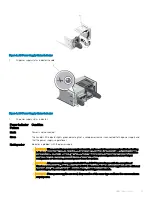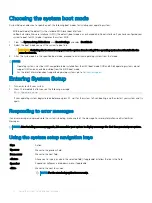
12 Press
>
until
»
is selected, and then press
✓
.
13 The LCD displays if you want to set up DNS. This is recommended, as setting up DNS enables you to program network resources on
the iDRAC based on DNS names, rather than requiring you to enter IP addresses.
a If you do not want to set up DNS, select
No
and press
✓
.
. Then select
Save
and press
✓
.
, configuration is complete.
b To set up DNS, select
Yes
, press
✓
, and continue to the next step.
14 The default DNS address (D1) is displayed on the LCD panel. Use the instructions in steps 5 and 6 to modify values as required.
15 The LCD panel displays the default address for an alternate DNS server (D2). An alternate server is optional, however provides
redundancy in case the primary DNS server fails. Use the instructions in steps 5 and 6 to modify values as required. If you do not want
to configure an alternate server, set all values to zeros.
16 When prompted to save, select
Yes
and press
✓
.
NOTE:
Settings are not applied until you press Yes to save. Also the display eventually times out and all unsaved
configuration changes are lost.
Diagnostic indicators
The diagnostic indicators on the system front panel display error status during system startup.
NOTE:
The diagnostic indicators are not present if the system is equipped with an LCD display.
NOTE:
The diagnostic indicators are present only on the 10-hard drive system.
The following section describes system conditions and possible corrective actions associated with these indicators:
Electrical indicator
Condition
Corrective Action
The indicator blinks
amber if the system
experiences an
electrical error (for
example, voltage
out of range, or a
failed power supply
or voltage
regulator).
See the System Event Log or system messages for the specific issue. If it is due to a
problem with the power supply, check the LED on the power supply. Re-seat the power
supply by removing and reinstalling it. If the problem persists, see
Temperature indicator
Condition
Corrective Action
The indicator blinks
amber if the system
experiences a
thermal error (for
example, a
temperature out of
range or fan failure).
Ensure that none of the following conditions exist:
•
A cooling fan is removed or has failed.
•
System cover, cooling shroud, EMI filler panel, memory-module blank, or back-filler
bracket is removed.
•
Ambient temperature is too high.
•
External airflow is obstructed.
12
About your system



























